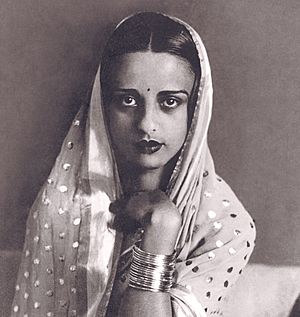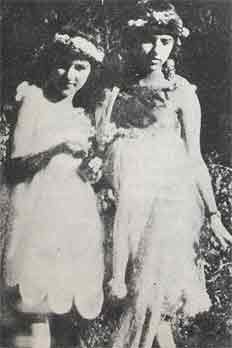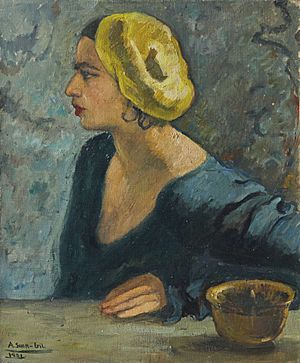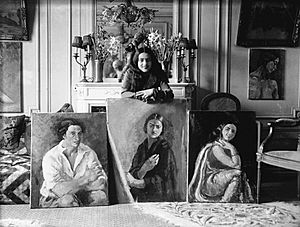Amrita Sher-Gil facts for kids
Quick facts for kids
Amrita Sher-Gil
|
|
|---|---|
 |
|
| Born | 30 January 1913 |
| Died | 5 December 1941 (aged 28) |
| Nationality | Hungarian / Indian |
| Education | Grande Chaumiere École des Beaux-Arts (1930–34) |
| Known for | Painting |
Amrita Sher-Gil (born January 30, 1913 – died December 5, 1941) was a famous Hungarian-Indian painter. Many people call her "one of the greatest new women artists of the early 1900s." She is also seen as a "pioneer" in modern Indian art.
Early Life and Learning
Amrita Sher-Gil was born in Budapest, Kingdom of Hungary. Her father, Umrao Singh Sher-Gil Majithia, was an Indian noble from the Majithia family. He was a scholar who studied Sanskrit and Persian. Her mother, Marie Antoinette Gottesmann, was a Hungarian opera singer from a wealthy family.
Amrita's parents met in 1912 when her mother visited Lahore. Her mother came to India with Princess Bamba Sutherland. Princess Bamba was the granddaughter of Maharaja Ranjit Singh.
Amrita was the older of two daughters. Her younger sister was Indira Sundaram. Amrita spent most of her early childhood in Budapest. Her uncle, Ervin Baktay, studied India. He noticed Amrita's art skills when he visited Shimla in 1926. He encouraged her to pursue art. He helped her by giving advice and a strong foundation for her art. When she was young, she would paint the people who worked in her house. She asked them to pose for her. Memories of these people later made her want to return to India.
Her family faced some money problems in Hungary. In 1921, her family moved to Summer Hill, Shimla, India. Amrita soon started learning piano and violin. By age nine, she and her sister Indira were performing concerts. They also acted in plays at Shimla's Gaiety Theatre. She had been painting since she was five. But she started formal art lessons at age eight. Major Whitmarsh and later Beven Pateman taught her art. In Shimla, Amrita lived a comfortable life. As a child, she was asked to leave her school. This happened because she said she did not believe in God.
In 1923, Amrita's mother met an Italian sculptor in Shimla. In 1924, he went back to Italy. Amrita and her mother also moved there. Amrita joined an art school in Florence called Santa Annunziata. She did not stay long at this school. She returned to India in 1924. But while there, she saw the works of famous Italian artists.
At sixteen, Sher-Gil traveled to Europe with her mother. She went to Paris to train as a painter. First, she studied at the Académie de la Grande Chaumière. Her teachers were Pierre Vaillent and Lucien Simon. She later studied at the École des Beaux-Arts from 1930 to 1934. She found inspiration from European painters. These included Paul Cézanne, Paul Gauguin, and Amedeo Modigliani. She worked under her teacher Lucien Simon. She also learned from her artist friends. In Paris, people said she painted with great passion. This was rare for a 16-year-old.
Artistic Career
Sher-Gil's early paintings show a strong influence from Western painting styles. She was especially influenced by Post-impressionism. In the early 1930s, she spent a lot of time with artistic groups in Paris.
Her 1932 oil painting, Young Girls, was a big success for her. This painting won her many awards. She received a gold medal. She was also chosen as an Associate of the Grand Salon in Paris in 1933. She was the youngest person ever to get this honor. She was also the only Asian artist to receive it. During this time, she painted many self-portraits. She also painted scenes of life in Paris. She did still life studies and portraits of her friends.
Sher-Gil returned to India at the end of 1934. In India, she started to explore Indian art traditions. She continued this search until her death. She was very impressed by Mughal and Pahari art styles. She also loved the cave paintings at Ajanta.
Sher-Gil is seen as a very important painter of 20th-century India. Her art is as important as that of the first artists of the Bengali Renaissance. Today, Sher-Gil's paintings are among the most expensive by Indian women painters. However, few people recognized her work when she was alive.
Death
In 1941, Amrita was 28 years old. Just days before her first big art show in Lahore, she became very sick. She fell into a coma. She left behind many artworks. Her last painting was not finished when she died. She passed away around midnight on December 5, 1941. The reason for her death has never been found out. Amrita was cremated on December 7, 1941, in Lahore.
Legacy
Sher-Gil's art has inspired many Indian artists. Her paintings show the challenges faced by women. This has made her art an inspiration for women everywhere. Some people called Sher-Gil "India's Frida Kahlo." This was because she bravely mixed Western and traditional art styles.
The Government of India has said her works are National Art Treasures. Most of her paintings are kept in the National Gallery of Modern Art in New Delhi. Some of her paintings are also in the Lahore Museum. Her art is so important to Indian culture. Because of this, when her art is sold in India, the government says it must stay in the country. Fewer than ten of her works have been sold outside India.
A postage stamp showing her painting 'Hill Women' was released in 1978 by India Post. There is also a road in Lutyens' Delhi named after her, called Amrita Shergil Marg.
Images for kids
See also
 In Spanish: Amrita Sher-Gil para niños
In Spanish: Amrita Sher-Gil para niños












